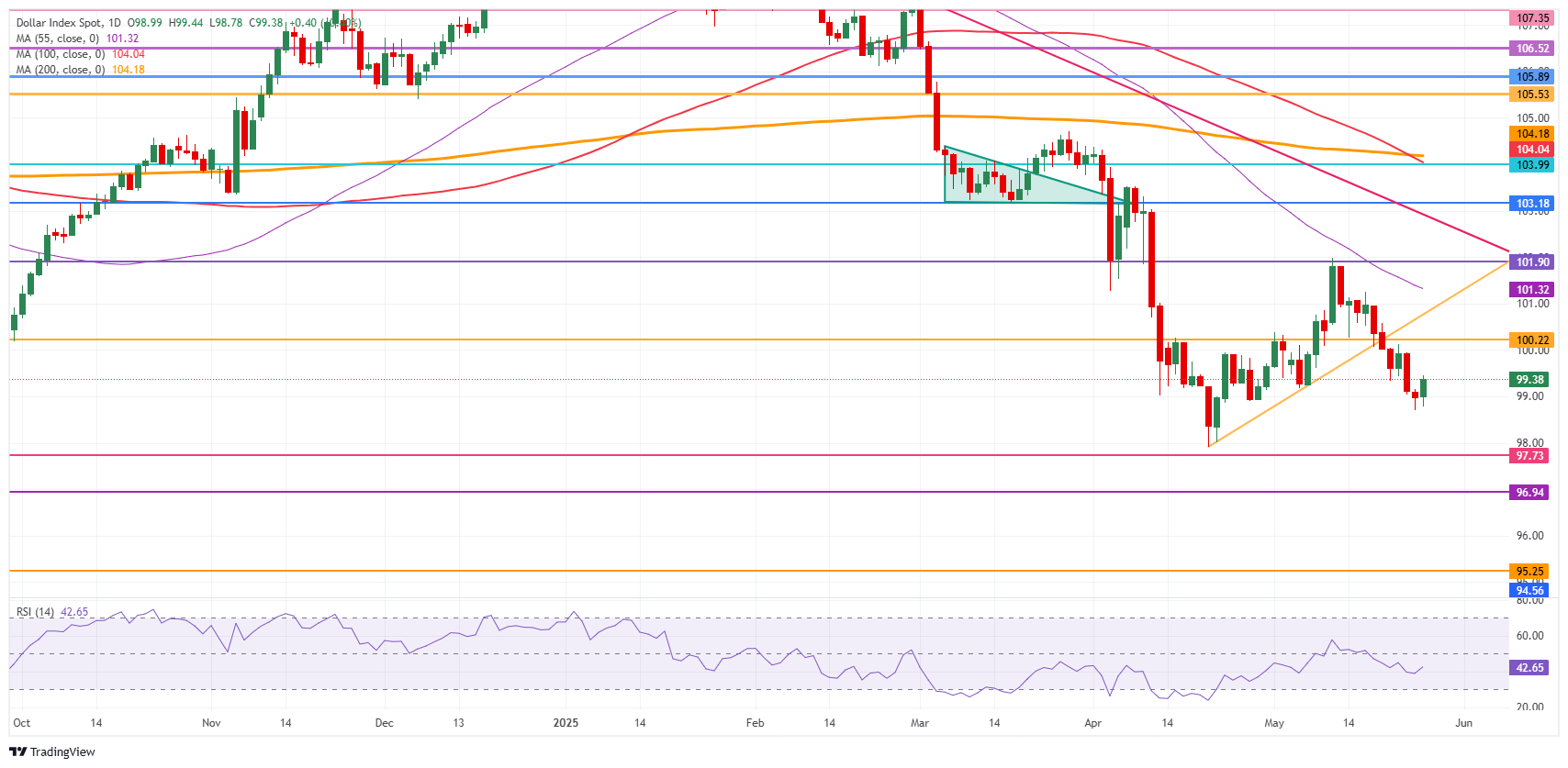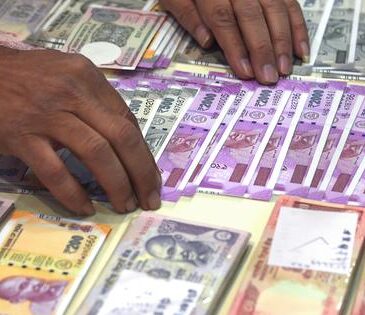- The US Dollar is making a turnaround this Tuesday, snapping its losing streak.
- Some support for the Greenback with the Fed confirming steady interest rates.
- The US Dollar Index heads above 99.00 in search of the 100.00 figure.
The US Dollar Index (DXY), which tracks the performance of the Greenback’s value against six major currencies, is tying up some minor gains, trading around 99.40 at the time of writing this Tuesday. The stronger Greenback has emerged right at the end of Asian trading hours, after the Japanese Ministry of Finance (MoF) commented that its bond issuance plan might see some tweaking, with lower volumes. This made Japanese yields collapse and saw the Japanese Yen (JPY) devalue against the Greenback, with a domino effect in favor of the US Dollar against several major currencies.
Meanwhile the Federal Reserve (Fed) has come out with comments from Minneapolis Fed Chairman Neel Kashkari, who commented that rates will remain steady until tariff clarity takes place. Fed’s Kashkari also pointed out that there are no quick wins in trade talks, and that these talks can take months or years to be concluded.
While markets are hopeful about a US-EU trade deal in the upcoming days, this week will start with US data due this Tuesday, after the Memorial Day public holiday, which kept markets closed. Traders can look ahead to the US Durable Goods Orders for April and the Dallas Federal Reserve (Fed) Manufacturing Business Index for May, which is a good leading indicator to see how the manufacturing sector is holding up after the introduction of tariffs.
Daily digest market movers: Here comes the first set of data for this week
- At 12:30 GMT, US Durable Goods Orders for April are due. The headline figure is expected to shrink by -7.9%, coming from 9.2% in March. US Durable Goods Orders without Transportation is expected to shrink by -0.1% from 0% in March.
- At 14:00 GMT, the US Consumer Confidence for May will be released, with no forecast available and the previous figure at 86.0.
- At 14:30 GMT, the Dallas Fed Manufacturing Business Index for May is due. No forecast available, with the previous number falling sharply by -35.8.
- Equities are seeing some small gains across the board in Asia and Europe. US futures are advancing much more aggressively, with all three major indices up over 1.50% ahead of the US trading session.
- The CME FedWatch tool shows the chances of an interest rate cut by the Federal Reserve in June’s meeting are only at a low 2.1%. Further ahead, the July 30 meeting sees odds for rates being lower than current levels at 24.4%.
- The US 10-year yield comes in at 4.47% at the time of writing, another leg lower from the 4.62% peak performance seen last Thursday.
US Dollar Index Technical Analysis: Eking out gains
The US Dollar Index is due for some recovery after a long stretch of devaluation, and that narrative is picking up this Tuesday after very early signs were seen on Monday. Expect to see the DXY swing back higher and look for firm resistance. That could trigger a firm rejection at higher levels and push the DXY beyond the low of May, causing more devaluation for the Greenback and losses for the DXY.
On the upside, the 100.22 level, which held the DXY back in September-October, is the first resistance, followed by the broken ascending trend line near 100.80. Further up, the 55-day Simple Moving Average (SMA) at 101.32 is the next level to watch out for, followed by 101.90, a pivotal level throughout December 2023 and a base for the inverted Head-and-Shoulders (H&S) formation during the summer of 2024. In case US Dollar bulls push the DXY even higher, the 103.18 pivotal level will come into play.
Should the DXY see some renewed selling pressure, a nosedive move could materialize towards the year-to-date low of 97.91 and the pivotal level of 97.73. Further below, a relatively thin technical support comes in at 96.94 before looking at the lower levels of this new price range. These would be at 95.25 and 94.56, meaning fresh lows not seen since 2022.

US Dollar Index: Daily Chart
US Dollar FAQs
The US Dollar (USD) is the official currency of the United States of America, and the ‘de facto’ currency of a significant number of other countries where it is found in circulation alongside local notes. It is the most heavily traded currency in the world, accounting for over 88% of all global foreign exchange turnover, or an average of $6.6 trillion in transactions per day, according to data from 2022.
Following the second world war, the USD took over from the British Pound as the world’s reserve currency. For most of its history, the US Dollar was backed by Gold, until the Bretton Woods Agreement in 1971 when the Gold Standard went away.
The most important single factor impacting on the value of the US Dollar is monetary policy, which is shaped by the Federal Reserve (Fed). The Fed has two mandates: to achieve price stability (control inflation) and foster full employment. Its primary tool to achieve these two goals is by adjusting interest rates.
When prices are rising too quickly and inflation is above the Fed’s 2% target, the Fed will raise rates, which helps the USD value. When inflation falls below 2% or the Unemployment Rate is too high, the Fed may lower interest rates, which weighs on the Greenback.
In extreme situations, the Federal Reserve can also print more Dollars and enact quantitative easing (QE). QE is the process by which the Fed substantially increases the flow of credit in a stuck financial system.
It is a non-standard policy measure used when credit has dried up because banks will not lend to each other (out of the fear of counterparty default). It is a last resort when simply lowering interest rates is unlikely to achieve the necessary result. It was the Fed’s weapon of choice to combat the credit crunch that occurred during the Great Financial Crisis in 2008. It involves the Fed printing more Dollars and using them to buy US government bonds predominantly from financial institutions. QE usually leads to a weaker US Dollar.
Quantitative tightening (QT) is the reverse process whereby the Federal Reserve stops buying bonds from financial institutions and does not reinvest the principal from the bonds it holds maturing in new purchases. It is usually positive for the US Dollar.




